北师大版(2019)选择性必修 第一册Unit 3 Conservation Viewing workshop 课件 (共17张PPT)
文档属性
| 名称 | 北师大版(2019)选择性必修 第一册Unit 3 Conservation Viewing workshop 课件 (共17张PPT) | 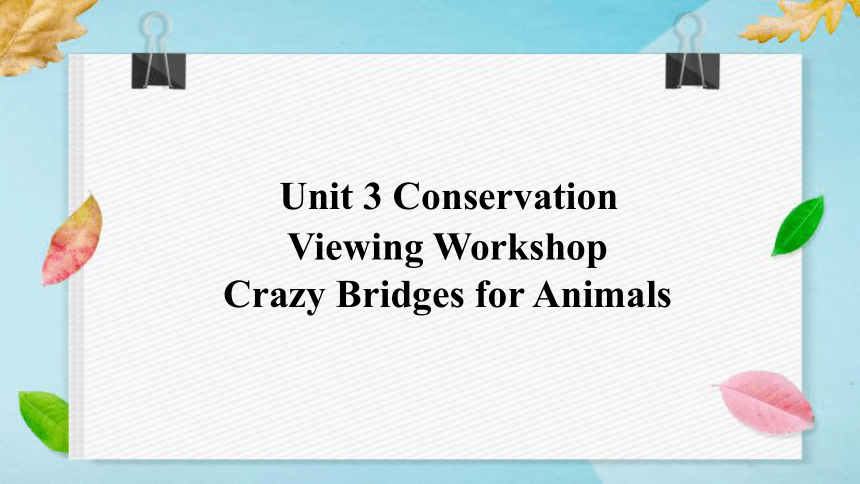 | |
| 格式 | pptx | ||
| 文件大小 | 130.2MB | ||
| 资源类型 | 教案 | ||
| 版本资源 | 北师大版(2019) | ||
| 科目 | 英语 | ||
| 更新时间 | 2024-10-12 22:59:58 | ||
图片预览

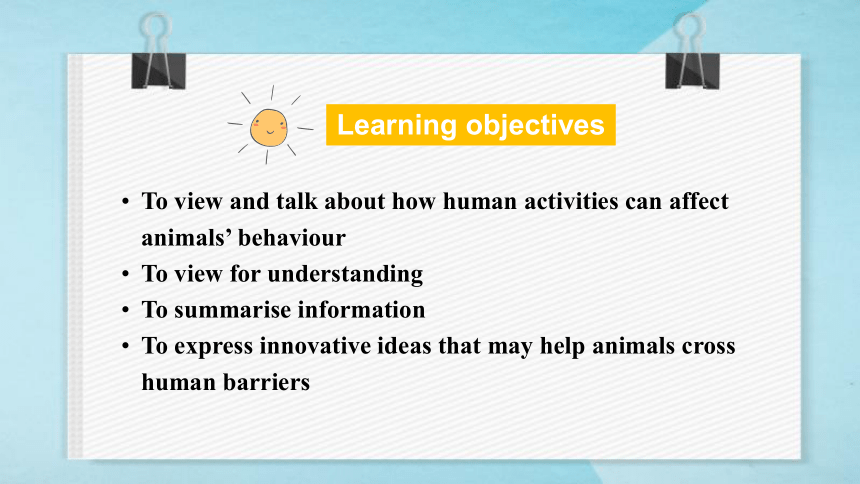
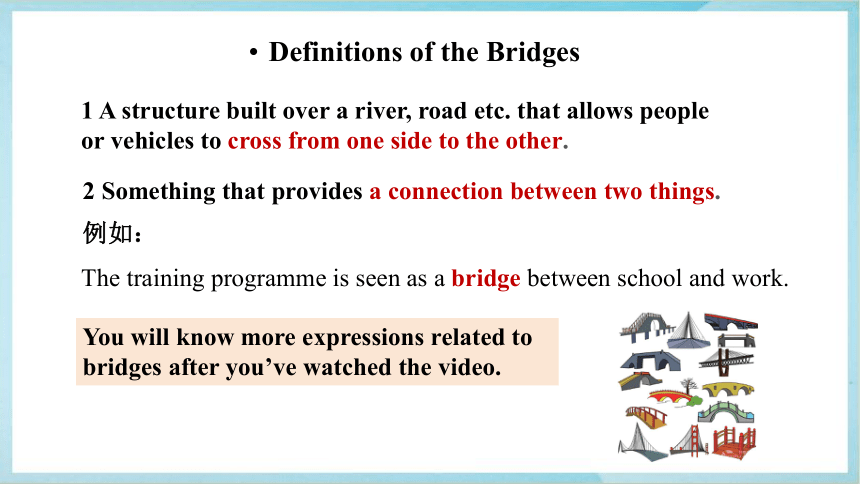
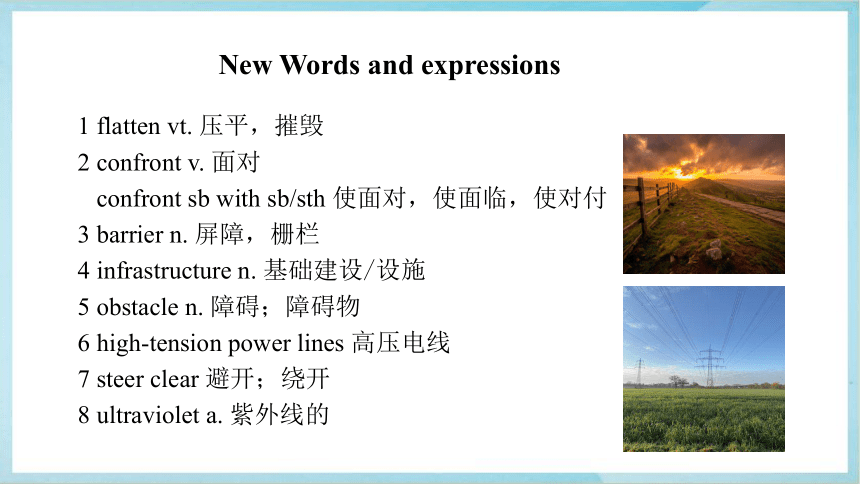
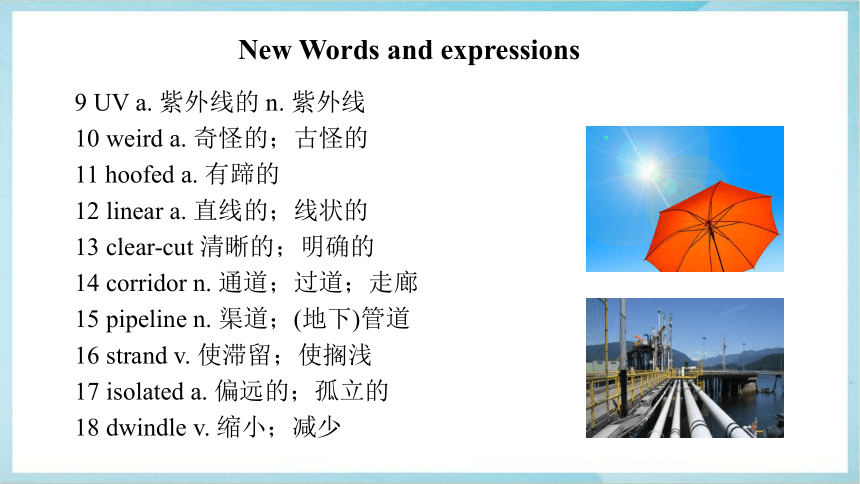
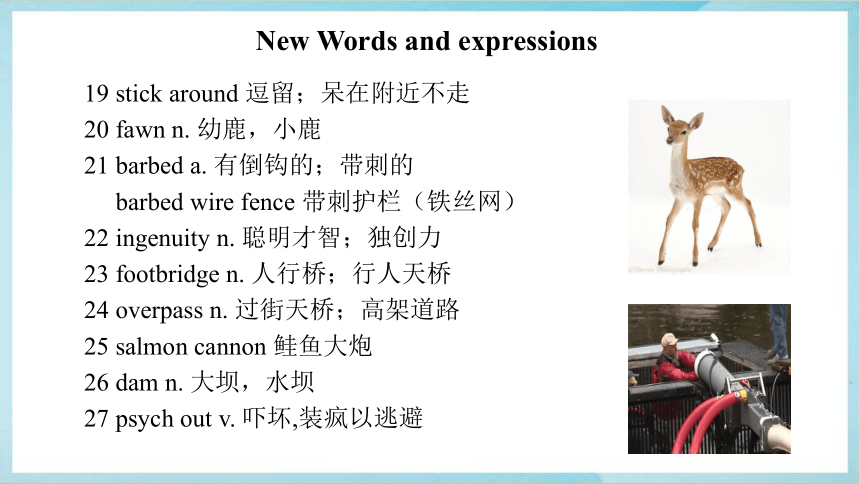
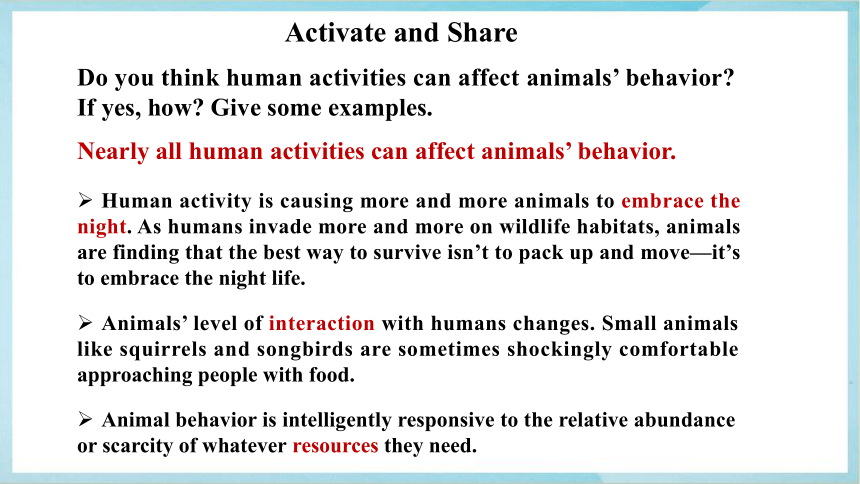
文档简介
(共17张PPT)
Unit 3 Conservation
Viewing Workshop
Crazy Bridges for Animals
To view and talk about how human activities can affect animals’ behaviour
To view for understanding
To summarise information
To express innovative ideas that may help animals cross human barriers
Learning objectives
Definitions of the Bridges
1 A structure built over a river, road etc. that allows people or vehicles to cross from one side to the other.
2 Something that provides a connection between two things.
You will know more expressions related to
bridges after you’ve watched the video.
The training programme is seen as a bridge between school and work.
例如:
New Words and expressions
1 flatten vt. 压平,摧毁
2 confront v. 面对
confront sb with sb/sth 使面对,使面临,使对付
3 barrier n. 屏障,栅栏
4 infrastructure n. 基础建设/设施
5 obstacle n. 障碍;障碍物
6 high-tension power lines 高压电线
7 steer clear 避开;绕开
8 ultraviolet a. 紫外线的
9 UV a. 紫外线的 n. 紫外线
10 weird a. 奇怪的;古怪的
11 hoofed a. 有蹄的
12 linear a. 直线的;线状的
13 clear-cut 清晰的;明确的
14 corridor n. 通道;过道;走廊
15 pipeline n. 渠道;(地下)管道
16 strand v. 使滞留;使搁浅
17 isolated a. 偏远的;孤立的
18 dwindle v. 缩小;减少
New Words and expressions
19 stick around 逗留;呆在附近不走
20 fawn n. 幼鹿,小鹿
21 barbed a. 有倒钩的;带刺的
barbed wire fence 带刺护栏(铁丝网)
22 ingenuity n. 聪明才智;独创力
23 footbridge n. 人行桥;行人天桥
24 overpass n. 过街天桥;高架道路
25 salmon cannon 鲑鱼大炮
26 dam n. 大坝,水坝
27 psych out v. 吓坏,装疯以逃避
New Words and expressions
Activate and Share
Do you think human activities can affect animals’ behavior If yes, how Give some examples.
Nearly all human activities can affect animals’ behavior.
Human activity is causing more and more animals to embrace the night. As humans invade more and more on wildlife habitats, animals are finding that the best way to survive isn’t to pack up and move—it’s to embrace the night life.
Animals’ level of interaction with humans changes. Small animals like squirrels and songbirds are sometimes shockingly comfortable approaching people with food.
Animal behavior is intelligently responsive to the relative abundance or scarcity of whatever resources they need.
View and Learn
w
Why did the chicken cross the road We may never know since she’s probably never got to the other side. This video presents different barriers animals face when living in human-built environments, and also offers some solutions.
Why did the chickens cross the road They thought it was an egg-cellent idea! Why did the dinosaur cross the road The chicken wasn’t around yet. Why did the cow cross the road Because the chicken was on holiday. Why did the chicken cross the playground To get to the other slide. Why did the dog cross the road twice He was trying to fetch a boomerang!
Why did The Chicken Cross The Road
Watch Part 1 of the video. Tick (√) the human-made things that affect animals’ lives.
□roads □ underpasses □ pipelines
□ footbridges □ painted lines □ clear-cut corridors
□ high-tension power lines □ rows of rocks
√
√
√
√
√
√
Watch Part 2 of the video. Write T (true) or F (false). Explain why.
( ) 1 It’s not likely for humans to get rid of roads, power or pipelines now.
T
F
T
One solution would be to get rid of all these obstacles, but we aren’t likely to give up roads, power or pipeline anytime soon.
( ) 2 High-tension power lines, as well as clear-out corridors, pipelines,
roads of rocks and painted lines on the ground do no harm to animals.
And even when we remove physical barriers, their stopping power can stick around. Generations of fawns learned to avoid the barbed wire fence, and even with it gone, the lessons live on.
They look harmless to us, but many other creatures steer clear, which means they do harm to animals.
( ) 3 Even if the barbed wire fence is removed, its stopping power can
stick around.
Watch Part 2 of the video. Write T (true) or F (false). Explain why.
In the final part, the speaker introduces some bridges which animals can use to cross the obstacles. Watch and match the animals with their possible bridges.
In the final part, the speaker introduces some bridges which animals can use to cross the obstacles. Watch and match the animals with their possible bridges.
Animals
Deer
Fish
Crabs
Elephants
Monkeys
Overpasses
Underneath
Salmon Cannons
Bridges
Watch the whole video and answer the following questions.
Watch the whole video and answer the following questions.
1 Why does the speaker give the example of a million animals flattened
by passing motorists each day
2 What consequences does building our own infrastructure bring to animals
To highlight the necessity of helping animals cross the barriers safely.
(1) Adding to the obstacle course without meaning to;
(2) Some of the most effective animal barriers are caused by these
unintentional fences.
3 What would happen if animals were stranded on one side
While one stranded cow might not be a huge problem, if enough animals became isolated from food, mates and protection, entire populations could dwindle (decline, drop) and even disappear.
4 What solutions are mentioned to help animals cross the barriers
(1) Building overpasses (bridges) that help animals cross dangerous roads;
(2) Engineering salmon cannons to help fish sail past dams;
(3) Bridging mental barriers to encourage animals to cross obstacles;
(4) Even if we don’t know why the chicken wants to cross the road, at least we can help her to get there safely. / Helping animals to cross the road safely.
Unit 3 Conservation
Viewing Workshop
Crazy Bridges for Animals
To view and talk about how human activities can affect animals’ behaviour
To view for understanding
To summarise information
To express innovative ideas that may help animals cross human barriers
Learning objectives
Definitions of the Bridges
1 A structure built over a river, road etc. that allows people or vehicles to cross from one side to the other.
2 Something that provides a connection between two things.
You will know more expressions related to
bridges after you’ve watched the video.
The training programme is seen as a bridge between school and work.
例如:
New Words and expressions
1 flatten vt. 压平,摧毁
2 confront v. 面对
confront sb with sb/sth 使面对,使面临,使对付
3 barrier n. 屏障,栅栏
4 infrastructure n. 基础建设/设施
5 obstacle n. 障碍;障碍物
6 high-tension power lines 高压电线
7 steer clear 避开;绕开
8 ultraviolet a. 紫外线的
9 UV a. 紫外线的 n. 紫外线
10 weird a. 奇怪的;古怪的
11 hoofed a. 有蹄的
12 linear a. 直线的;线状的
13 clear-cut 清晰的;明确的
14 corridor n. 通道;过道;走廊
15 pipeline n. 渠道;(地下)管道
16 strand v. 使滞留;使搁浅
17 isolated a. 偏远的;孤立的
18 dwindle v. 缩小;减少
New Words and expressions
19 stick around 逗留;呆在附近不走
20 fawn n. 幼鹿,小鹿
21 barbed a. 有倒钩的;带刺的
barbed wire fence 带刺护栏(铁丝网)
22 ingenuity n. 聪明才智;独创力
23 footbridge n. 人行桥;行人天桥
24 overpass n. 过街天桥;高架道路
25 salmon cannon 鲑鱼大炮
26 dam n. 大坝,水坝
27 psych out v. 吓坏,装疯以逃避
New Words and expressions
Activate and Share
Do you think human activities can affect animals’ behavior If yes, how Give some examples.
Nearly all human activities can affect animals’ behavior.
Human activity is causing more and more animals to embrace the night. As humans invade more and more on wildlife habitats, animals are finding that the best way to survive isn’t to pack up and move—it’s to embrace the night life.
Animals’ level of interaction with humans changes. Small animals like squirrels and songbirds are sometimes shockingly comfortable approaching people with food.
Animal behavior is intelligently responsive to the relative abundance or scarcity of whatever resources they need.
View and Learn
w
Why did the chicken cross the road We may never know since she’s probably never got to the other side. This video presents different barriers animals face when living in human-built environments, and also offers some solutions.
Why did the chickens cross the road They thought it was an egg-cellent idea! Why did the dinosaur cross the road The chicken wasn’t around yet. Why did the cow cross the road Because the chicken was on holiday. Why did the chicken cross the playground To get to the other slide. Why did the dog cross the road twice He was trying to fetch a boomerang!
Why did The Chicken Cross The Road
Watch Part 1 of the video. Tick (√) the human-made things that affect animals’ lives.
□roads □ underpasses □ pipelines
□ footbridges □ painted lines □ clear-cut corridors
□ high-tension power lines □ rows of rocks
√
√
√
√
√
√
Watch Part 2 of the video. Write T (true) or F (false). Explain why.
( ) 1 It’s not likely for humans to get rid of roads, power or pipelines now.
T
F
T
One solution would be to get rid of all these obstacles, but we aren’t likely to give up roads, power or pipeline anytime soon.
( ) 2 High-tension power lines, as well as clear-out corridors, pipelines,
roads of rocks and painted lines on the ground do no harm to animals.
And even when we remove physical barriers, their stopping power can stick around. Generations of fawns learned to avoid the barbed wire fence, and even with it gone, the lessons live on.
They look harmless to us, but many other creatures steer clear, which means they do harm to animals.
( ) 3 Even if the barbed wire fence is removed, its stopping power can
stick around.
Watch Part 2 of the video. Write T (true) or F (false). Explain why.
In the final part, the speaker introduces some bridges which animals can use to cross the obstacles. Watch and match the animals with their possible bridges.
In the final part, the speaker introduces some bridges which animals can use to cross the obstacles. Watch and match the animals with their possible bridges.
Animals
Deer
Fish
Crabs
Elephants
Monkeys
Overpasses
Underneath
Salmon Cannons
Bridges
Watch the whole video and answer the following questions.
Watch the whole video and answer the following questions.
1 Why does the speaker give the example of a million animals flattened
by passing motorists each day
2 What consequences does building our own infrastructure bring to animals
To highlight the necessity of helping animals cross the barriers safely.
(1) Adding to the obstacle course without meaning to;
(2) Some of the most effective animal barriers are caused by these
unintentional fences.
3 What would happen if animals were stranded on one side
While one stranded cow might not be a huge problem, if enough animals became isolated from food, mates and protection, entire populations could dwindle (decline, drop) and even disappear.
4 What solutions are mentioned to help animals cross the barriers
(1) Building overpasses (bridges) that help animals cross dangerous roads;
(2) Engineering salmon cannons to help fish sail past dams;
(3) Bridging mental barriers to encourage animals to cross obstacles;
(4) Even if we don’t know why the chicken wants to cross the road, at least we can help her to get there safely. / Helping animals to cross the road safely.
同课章节目录
- Unit 1 Relationshis
- Lesson 1 Teachers
- Lesson 2 How Do We Like Teachers’ Feedback?
- Lesson 3 So Close,Yet So Fa
- Unit 2 Success
- Lesson 1 Money vs Success
- Lesson 2 Top Five Secrets of Success
- Lesson 3 Getting to the Top
- Unit 3 Conservation
- Lesson 1 The Sixth Extinction
- Lesson 2 War on Plastic Packets
- Lesson 3 The Road to Destruction
